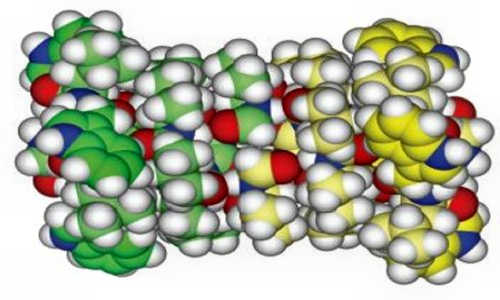A good drug is hard to design: to garner FDA approval and reach consumers, it must not only effectively treat a medical condition, but it must also do so without having side effects that outweigh its benefits.
This is gramicidin, a membrane-spanning protein used to monitor lipid bilayer disruption in the Gramicidin-Based Fluorescence Assay. Photo Credit: Andersen Lab, Weil Cornell Medical College
Sometimes, toxic side effects aren’t discovered until fairly late in the drug development process, when substantial amounts of time and money have already been invested in clinical trials. Even though the pharmaceutical industry uses preclinical data and predictive algorithms to weed out drugs that are likely to fail because of toxicity, many still slip through the cracks.
Now, a group of researchers from Weill Cornell Medical College in New York City has devised a new drug screen that capitalizes on the tendency of toxic compounds to alter the properties of the lipid bilayer that encases cells. They will present their screening method at the 59th annual meeting of the Biophysical Society, held Feb. 7-11 in Baltimore, Md.
Changes to the properties of the lipid bilayer component of the cell membrane can alter the function of proteins embedded in the membrane — proteins that regulate critical functions such as transport of materials in and out of the cell and communication with other cells.
The new screen, called the Gramicidin-Based Fluorescence Assay (GBFA), repurposes an assay previously developed by principal investigator Olaf Andersen and a former graduate student Helgi Ingólfsson. It tracks changes in the activity of a small protein (the gramicidin channel) coupled to a fluorescence signal as a way of monitoring changes in lipid bilayer properties, a correlate for toxicity.
“As we gathered data, we began to notice a trend: molecules that significantly affected lipid bilayer properties were often indiscriminate modifiers of membrane protein function and thus tended to have an array of off-target effects,” said researcher Lea Sanford. That is, when compounds intended to influence a specific protein target also alter lipid bilayer properties, they may alter the function of numerous membrane proteins and thereby cause a cascade of usually unwanted off-target and side effects.
Sanford and her colleagues wanted to see whether changes in lipid bilayer properties were reliably correlated with a drug’s toxicity to cells, or cytotoxicity. To test the hypothesis, they did a blinded screen of 134 compounds provided by The Rockefeller University’s High-Throughput Screening Center. Indeed, the toxic compounds in the database, which had been characterized using high-content cytotoxicity screening, showed greater rates of fluorescence quenching. The greater a molecule’s bilayer-modifying effect (the faster the fluorescent signal decreased during the assay), the higher the likelihood it would be toxic. It appears that, as the team expected, the test could be used to identify probable cytotoxic drugs.
“This is our first study on toxicity and our results imply that the GBFA is a viable, cheap and straightforward option for predicting which compounds are likely to have off-target effects and potentially be cytotoxic, thus having the potential to indicate likely drug failures at an early stage in the development process,” said Sanford. “We need to expand the library of compounds tested to more thoroughly vet the assay’s use in this way.”
The researchers also emphasized that changes in bilayer properties are not inherently negative. In some cases, the off-target effects of a drug could make it useful for treating conditions other than the one for which it was originally developed.
“A molecule may be toxic for many reasons that do not involve the bilayer, but it is striking how increased bilayer activity tends to be associated with toxicity,” noted Andersen. “The cool thing about this project is that it shows that lipid bilayers will continue to surprise us.”





